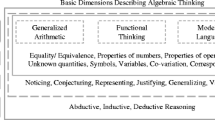Abstract
Simplifying symbolic expressions is usually perceived in middle school algebra as an algorithmic activity, achieved by performing sequences of short drill-and-practice tasks, which have little to do with conceptual learning or with creative mathematical thinking. The aim of this study is to explore possible ways by which ninth-grade students can be encouraged to apply flexible and creative thinking in the context of a task that requires students to design a multiple-choice questionnaire on equivalent algebraic expressions. Fifty-six ninth-grade students answered Take-a-Quiz and Make-a-Quiz questionnaires. The findings indicate that students can be engaged in a satisfactory way in these kinds of non-routine tasks. Also, about two-thirds of the participating students were able to display a medium or high level of originality in their construction of equivalent expressions. In addition, an analysis of the non-equivalent expressions suggested by the participating students as distractors indicated a relatively high level of awareness to the most common errors that might occur in this type of activity.

Similar content being viewed by others
References
Booth, L. R. (1988). Children’s difficulties in beginning algebra. In A. F. Coxford & A. P. Shulte (Eds.), The ideas of algebra K-12, 1988 yearbook of teachers of mathematics (NCTM) (pp. 20–32). Reston: NCTM.
Borasi, R. (1994). Capitalizing on errors as “springboards for inquiry”: A teaching experiment. Journal for Research in Mathematics Education, 25, 166–208.
Borasi, R. (1996). Reconceiving mathematics instruction: A focus on errors. Greenwood Publishing Group.
Ervynck, G. (1991). Mathematical creativity. In D. Tall (Ed.), Advanced mathematical thinking (pp. 42–53). Dordrecht: Kluwer.
Friedlander, A., & Arcavi, A. (2012). Practicing algebraic skills, a conceptual approach. Mathematics Teacher, 105(8), 608–614.
Guilford, J. P. (1967). The nature of human intelligence. New York: McGraw-Hill.
Kieran, C. (1992). The learning and teaching of school algebra. In D. A. Grouws (Ed.), Handbook of research on mathematics teaching and learning (pp. 390–419). New York: Macmillan.
Kieran, C., & Sfard, A. (1999). Seeing through symbols: The case of equivalent expressions. Focus on learning problems in mathematics, 21(1), 1–17.
Leikin, R. (2009). Exploring mathematical creativity using multiple solution tasks. In R. Leikin, A. Berman, & B. Koichu (Eds.), Creativity in mathematics and the education of gifted students (pp. 129–135). Rotterdam: Sense Publishers.
Leikin, R., & Lev, M. (2007). Multiple solution tasks as a magnifying glass for observation of mathematical creativity. In J. H. Woo, H. C. Lew, K. S. Park, & D. Y. Seo (Eds.), Proceedings of the 31st International Conference for the Psychology of Mathematics Education (Vol. 3, pp. 161–168). Seoul: The Korea Society of Educational Studies in Mathematics.
Leikin, R., & Pitta-Pantazi, D. (Eds.) (2013). Creativity and mathematics education: the state of the art. ZDM - The International Journal on Mathematics Education, 45(2), 159–166.
Macgregor, M., & Stacey, K. (1997). Students’ understanding of algebraic notation: 11–15. Educational Studies in Mathematics, 33(1), 1–19.
Matz, M. (1982). Towards a process model for high-school algebra errors. In D. Sleeman & J. S. Brown (Eds.), Intelligent tutoring systems (pp. 25–50). London: Academic Press.
Rojano, T., & Sutherland, R. (2001). Algebraic reasoning with spreadsheets. In Proceedings of the international seminar “Reasoning explanation and proof in school mathematics and their place in the intended curriculum”. Qualifications and Curriculum Authority (pp. 1–16). Cambridge, UK.
Sak, U., & Maker, C. J. (2006). Developmental variations in children’s creative mathematical thinking as a function of schooling, age, and knowledge. Creativity Research Journal, 18(3), 279–291.
Singer, F. M., Ellerton, N., & Cai, J. (Eds.) (2013). Problem-posing research in mathematics education: new questions and directions. Educational Studies in Mathematics, 83(1), 1–7. doi: 10.1007/s10649-013-9478-2.
Sternberg, R. J., & Lubart, T. I. (1996). Investing in creativity. American Psychologist, 51, 677–688.
Tabach, M., & Friedlander, A. (2008a). Understanding equivalence of symbolic expressions in a spreadsheet-based environment. International Journal of Computers for Mathematical Learning, 13(1), 27–46.
Tabach, M., & Friedlander, A. (2008b). The role of context in learning beginning algebra. In C. E. Greens (Ed.), Algebra and algebraic thinking in school mathematics, 2008 yearbook (pp. 223–232). Reston: The National Council of Teachers of Mathematics.
Tabach, M., & Friedlander, A. (2013). School mathematics and creativity at the elementary and middle grade level: How are they related? ZDM - The International Journal on Mathematics Education, 45, 227–238. doi:10.1007/s11858-012-0471-5.
Tirosh, D., Even, R., & Robinson, N. (1998). Simplifying algebraic expressions: Teacher awareness and teaching approaches. Educational studies in mathematics, 35(1), 51–64.
Torrance, E. P. (1974). Torrance tests of creative thinking. Bensenville: Scholastic Testing Service.
Usiskin, Z. (1988). Conceptions of school algebra and uses of variables. In A. F. Coxford & A. P. Shulte (Eds.), The ideas of algebra K-12, 1988 yearbook of teachers of mathematics (NCTM) (pp. 8–19). Reston: NCTM.
Zazkis, R., & Leikin, R. (2007). Generating examples: From pedagogical tool to a research tool. For the Learning of Mathematics, 27(2), 15–21.
Author information
Authors and Affiliations
Corresponding author
Rights and permissions
About this article
Cite this article
Tabach, M., Friedlander, A. Algebraic procedures and creative thinking. ZDM Mathematics Education 49, 53–63 (2017). https://doi.org/10.1007/s11858-016-0803-y
Accepted:
Published:
Issue Date:
DOI: https://doi.org/10.1007/s11858-016-0803-y




